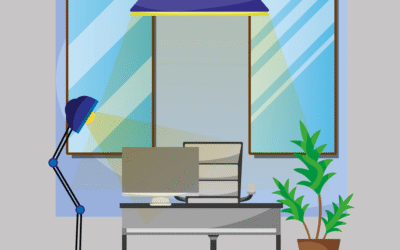From layout to lighting, learn how simple design changes can lead to better focus, energy, and results.
There is enough evidence to support the claim that office comfort can affect productivity…by improving the office environmental conditions, occupier productivity could be increased by 4–10%.
— Barry P. Haynes, Sheffield Hallam University
Why Office Design Affects Productivity
The physical workspace directly impacts how people think, feel, and perform. Poor lighting, noise, clutter, or uncomfortable furniture can cause fatigue, distractions, and reduced focus.
A well-designed office supports mental clarity, smoother workflows, and consistent energy, all of which contribute to a more productive team.
Design is more than looks. It helps people work smarter and perform better.
— Steve Jobs
Design Factors That Influence Output
- Lighting: Natural light improves mood and alertness. When it’s not available, use layered lighting with adjustable brightness to reduce eye strain and fatigue.
- Layout: A thoughtful layout supports different types of work. Open areas encourage teamwork, while quiet zones allow for deep focus. A flexible layout helps employees stay engaged and efficient.
- Noise Control: Distractions from conversations or background noise reduce productivity. Use acoustic panels, partitions, soft furnishings, or designated quiet areas to manage sound levels.

- Furniture and Ergonomics: Poor posture leads to discomfort and reduced energy. Adjustable chairs, sit-stand desks, and well-placed monitors create a healthier, more focused work environment.
- Organization and Storage: Visual clutter increases mental load. Smart storage solutions, cable management, and clean desk setups help maintain a clear and efficient workspace.
- Temperature and Air Quality: An office that is too hot, cold, or stuffy can impact energy and focus. Keep temperatures comfortable and consistent, and use ventilation or air purifiers to ensure good air quality.

Common Design Mistakes That Hurt Productivity
- Overuse of Open Plans: Fully open layouts can increase noise and distractions. Without quiet areas, employees may struggle to focus on deep work.
Pro-tip: Place photocopiers in a central spot with some visual or acoustic separation. In small offices, position them in a corner and use partitions to shield nearby desks.
- Poor Lighting Balance: Relying only on overhead fluorescent lights can cause glare or eye strain. A lack of natural light also affects mood and energy.
- Lack of Defined Zones: When spaces are not clearly separated by function, collaboration, meetings, and focused work often clash in the same area.
- Ignoring Acoustics: Hard surfaces and open ceilings can amplify sound. Without acoustic treatments, even small offices can feel noisy and chaotic.
- Inflexible Furniture and Layouts: Fixed desks and rigid layouts make it harder to adapt the space for changing team sizes or work styles.
- Clutter and Storage Gaps: Not enough storage leads to cluttered desks and shared spaces, which can mentally drain employees and reduce efficiency.
Quick Fixes for a More Productive Office
- Rearrange for Better Flow: Move desks or furniture to create clearer pathways and reduce crowding. Align work areas with how teams naturally interact.
- Add Task Lighting: Provide desk lamps or adjustable lights in work areas where overhead lighting is too harsh or uneven.
- Introduce Acoustic Elements: Use rugs, fabric panels, or standing dividers to absorb noise and define quiet zones without major construction.
- Bring in Plants: Adding greenery improves air quality and can create a calming, focused environment with minimal effort.
- Declutter Work Surfaces: Encourage clean desk habits and provide easy-to-access storage options to keep shared and personal spaces organized.
- Create Micro Zones: Add a small focus nook, phone booth, or soft seating area to give employees options for different work modes.
- Adjust Temperature Settings: Keep office temperature consistent and comfortable. Provide desk fans or portable heaters where needed to improve comfort without changing the whole system.
How We Measure Productivity Impact Through Design
Environmental Checks: Light levels (lux), noise (decibels), temperature, and air quality are assessed using portable tools or apps.
Observation and Use: We look at how people move, collaborate, and use spaces day to day to spot inefficiencies and interruptions.
Staff Feedback: Quick surveys to track changes in focus, comfort, and energy levels before and after design updates.
Conclusion
A productive workplace is shaped by more than just schedules and tools. The design of the physical environment plays a key role in how people focus, collaborate, and perform.
By making intentional changes to lighting, layout, acoustics, and comfort, office managers and business owners can create spaces that support better work.
Small improvements lead to meaningful results.
Back to office interior design guide
Explore Related Topics
- Soundproofing Solutions Guide






0 Comments